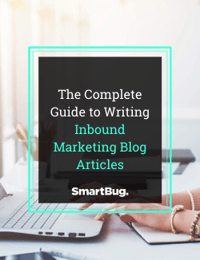
Beyond the Basics: Next-Level Tips for Writing Inbound Blog Articles
April 7, 2020
Writing blog articles for inbound marketing shouldn’t be scary—if anything, it should be fun to write about your business. And with practice, marketers and other employees in your organization who might not consider themselves good writers can turn into competent, interesting journalists.
These writing tips go beyond the basics but aren’t necessarily advanced—they just provide some other things to consider when crafting content:
Avoid Copy-and-Paste
The inventor of the cut, copy, and paste functions in modern software recently died. We salute his invaluable contribution to the world of content … and forgive him for the headaches he inadvertently unleashed.
Blog copy should be as original as possible. Copying and pasting from other sources—even your own—puts that originality at risk. Many plagiarism incidents have occurred because the writer pasted info from another source for reference and then, either intentionally or accidentally, didn’t delete it from the document.
Borrowing from your organization’s own content via copy-and-paste isn’t a best practice. Consistency in your messaging is important, but verbatim repetition can hurt SEO and leave readers wondering, “Didn’t I already see this?”
Therefore, try avoiding—or at least be extremely careful with—copying and pasting. With your own content, you can bring copy in to convert into new wordings. With external sources, don’t even risk pasting someone else’s words into your document (unless, of course, they’re properly quoted and cited).
Write to Your Brand
Your brand projects an image of what product or service it offers, what it can do for the customer, and what its mission is. Naturally, blog content should reflect that brand messaging, yet many writers miss the mark, delivering a potentially great article that fails to match the company publishing it.
An organization that emphasizes its authority shouldn’t be wishy-washy with its blog articles. Alternately, a brand focused on community shouldn’t come off all “me, me, me” with its content. Understanding your brand may seem obvious, but neglecting this can confuse readers and diminish your overall marketing strategy.
Write to Your Audience
Similarly, understanding your audience, in the form of inbound marketing personas, is crucial to writing articles that appeal to their needs and address their concerns. This is another best practice writers often overlook.
For example, a bank creates an article about student loans but gears the copy toward senior adults instead of college students and their parents. As a result, the content won’t resonate with the correct audience and won’t be read by the accidentally intended audience ...
Personas comprise a key tenet of inbound marketing, so if yours aren’t well-defined, prioritize that effort before tackling more content. If your personas are set, stay focused on which one your article is targeting. Some topics may appeal to more than one or all of your personas, which is fine—this offers more flexibility but it also presents additional challenges as you write for a broader audience.
Follow a Style Guide
Most readers won’t care if you use the serial comma or singular “they” in your copy—but they might notice if you aren’t consistent with punctuation, grammar, word usage, and spelling. Moreover, if multiple writers are producing content for your blog, they’re bound to type things differently if you don’t set some basic ground rules in the form of a style guide.
Businesses can choose from several existing style guides—AP and Chicago, for example—or create their own. Style can also be fluid, so if you decide to change how you capitalize the job titles of people in your organization, you can declare it so and follow the new rule from there. What’s most important is that your writers are on the same page with style, which, ultimately, strengthens your content.
Don’t Write the Way You Talk
I like sharing a rule that Mr. Zielinski, my English teacher when I was a high school freshman a few decades ago, taught the class. All these years later I haven’t forgotten it:
Don’t write like you talk!
(The exclamation point is mine.)
I’m a strong believer of Mr. Z’s rule—that common speech is a root of poor writing. Not writing like you talk means (and this list is by no way comprehensive):
- Avoiding go and going when you’re not actually going anywhere
- Using action verbs instead of relying on have, has, and had
- Using action verbs instead of do (e.g., I should do the dishes)
- Being as succinct as possible
- Writing in complete sentences, with a subject and predicate
- Avoiding colloquial terms and spelling (e.g., ain’t, gotta, livin’, dammit)
- Not talking/writing just to hear yourself talk/write
Some non-writers may say that writing like you talk is more appealing for the reader. Forgive me: Um, no! You can be conversational, and you can even be a little creative and fun. However, you shouldn’t write unprofessionally, no matter the audience. Honor Mr. Zielinski by following this rule and keeping your speech and prose separate.
One Last Edit
All your hard work—the keyword research, the links you’ve added, the careful consideration of every word you’ve written—is about to pay off in the form of a completed blog article. Whether you are publishing the post yourself or handing it off to an editor or coworker for review, you should perform one more task before pressing the metaphorical “send” button: Give the article one more read.
A final edit helps you catch anything you might have missed during the initial writing and revising. No one is perfect, but you want your copy to be as close to perfect as possible before it goes live. Some tips for this final edit include:
- Spell-check the document: The spelling and grammar checks on writing programs such as Microsoft Word and Google Docs, as well as HubSpot’s blog editor, aren’t perfect, which is why they shouldn’t be solely relied upon—but they are useful for catching some errors you might have missed.
- Click on all your links: Make sure that you applied the correct links to the corresponding copy and that those links are still working since the time you first viewed them.
- Step away for a few minutes: If the words on the screen are not registering in your brain—even though you wrote all of them—take a break before your final read. The time away usually provides a fresher perspective as you conclude the process.
- Read out loud: We’re conditioned to silently read at a quick pace to get through the text, but that’s not the goal with your last edit. Instead, read the copy out loud (even if it’s a quiet” loud) and be sure to read every word. This strategy often catches mistakes that seemed correct when you were just perusing with your eyes.
After the last read, allow yourself a celebratory “Woo!” … and start thinking about your next article. An inbound marketing blog is a journey, and the more content you write, the better informed leads will be—and the greater the likelihood those leads will turn into customers.

About the author
Joe Gillespie is Director of Inbound Copy for SmartBug Media. He graduated from Marquette University with a B.A. in journalism and, before coming to SmartBug, was a two-decade veteran of the newspaper industry. Read more articles by Joe Gillespie.





















